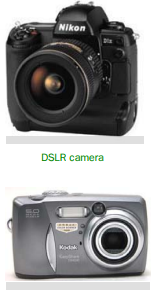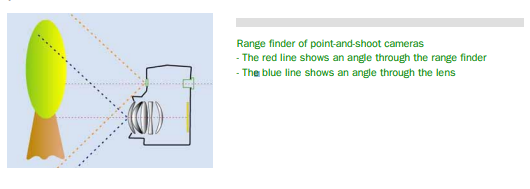1.3: What is a DSLR camera?
- Page ID
- 151074
There are two very different classes of digital cameras:
point-and-shoot (p/s, fixed-lens) and Digital-Single-LensReflex (DSLR). The digital cameras most people have are point-and-shoot cameras which are small and cute. On the other hand, the DSLR cameras are larger like the one pictured here. DSLR cameras are usually for professional photographers, but currently many non-professionals are interested in using DSLR cameras. Even if two cameras have the same number of pixels, a DSLR camera is more expensive than a point-and-shoot camera. In addition, because DSLR cameras have a larger CCD, the quality of the photo is better. However, don’t be disappointed in having a point-and-shoot camera. Recently, those p/s cameras have many functions like DSLRs.


These two kinds of cameras have different types of view finder. A regular digital camera (p/s) has a range finder requiring an additional view finder, which is separate from the lens, to see a subject. This kind of camera is light, fast, and silent. However, the image viewed through a view finder is different from the image viewed through a lens because a view finder is in a different location coming from a different angle as in the following
picture.

In contrast, DSLR cameras have just one lens. There is a mirror in the camera. You can see the subject from the same angle as the lens. Therefore, you can add additional lenses to a DSLR camera.

The following table explains the differences between point-and-shoot camera and DSLR cameras
| Point-and-shoots | DSLR | |
| Strengths | Small & light, silent Good light metering Ability to record movies |
Better image quality Instant operation, Fast AF(Auto Focus) Huge lens range |
| Weaknesses | Lower image quality Slow operation & AF |
Large & heavy noisy |
• It is generally smaller, lighter, and more silent than a DSLR camera.
• The camera already knows what the exposure should be because the image sensor is exposed to the image while you are composing.
• Most cameras let you make movie files with sound, such as mpg, avi or mov file. DSLR cameras can not make movies because of their reflex mirrors.
• Because it has a small CCD and tiny pixels compared to DSLR, there are two flaws: much more distortion(grain) in photos and much slower ISO speed.
• Overall these cameras are not as fast as we’d like. For example, you have to wait for them to turn on after pressing the button. In addition, they don’t focus very quickly because they have tiny motors.
• DSLRs have sensors almost as big as 35mm film, which is about five times the linear dimension or 25 times as much area as the sensors in p/s cameras. These huge pixels gulp in every last photon of light so even at high ISO settings the images are much cleaner than p/s cameras. This lets you use high ISOs all the time, with even better results than film in low light.
• You can turn them on very quickly and take a picture right after pressing the button. DSLRs have the fast AF motors of their film cousins. They also can track subjects in motion for great sports shots.
• You can use all the lenses you already own and can buy new and used ones. Even a 15 year old autofocus or 40 year old manual focus lens can be used, depending on your camera
• DSLRs tend to be large and heavy although the latest inexpensive ones are as light and as small as the biggest p/s models at the same price.
• DSLRs have a lot of motors and mechanics which make the same noise.
Do I have to buy an expensive DSLR camera to get good quality photos?
The best answer is “Not necessarily”. You can take superb photos with most of the midlevel digital cameras on today’s market. Most of us tend to believe that a more expensive camera will produce better photos. The truth is that having a more expensive camera will no more improve your photos than buying an expensive golf club will automatically improve your golf game. Not only do the point-and-shoot cameras help beginners to automatically adjust setting but they are offering manually changing setting to us. The most important thing is how to effectively use your camera using photographic knowledge.
How to select the right camera for you?
There are important considerations when you are looking for a digital camera.
• Budget
You know which models are affordable to you.
• Experience level
If you are a beginner, find models that seem easy to use. There are so many kinds of models in stores. Go to the store and handle different cameras. If you are more experienced, you may want a camera that gives the user more control even of it is not a DSLR camera.
• Sensor size (e.g. 3, 4 or 5 megapixels)
The size of the sensor means how large you can enlarge the resulting photo. The large size does not mean you can take better photos. If you were to take a color photograph of a scene with three cameras with different-sized sensors (3,4 or 5 megapixels), the 4X6 or 5X7 inch prints would appear to be the same quality. If you do want to make lager photos, the larger sensor size is needed.
• Zoom factor
You should consider the optical zoom factor which describes the amount of enlargement produced by the camera’s lens. The digital zoom factor is created by electronically magnifying the image. It degrades the quality of the image by literally cropping from the center of thesensor. The optical zoom factor is the most important thing.
• Camera mode
Look for cameras that have the best feature (mode) you need. Look carefully at the specifications of the cameras. For example, does it offer different scene modes? Does it offer the shutter priority mode?
• Memory and battery
If you already have other digital devices such as a digital camcorder or PDA that uses a digital memory card, it would be a good idea to decide on a camera that uses the same kind of memory you currently have. Determine what type of batteries the camera uses. If you are a frequent shooter and it takes AA batteries, you will blow through them. A rechargeable battery may be a better choice such as Li-ion battery, but I recommend you to buy an extra battery.

